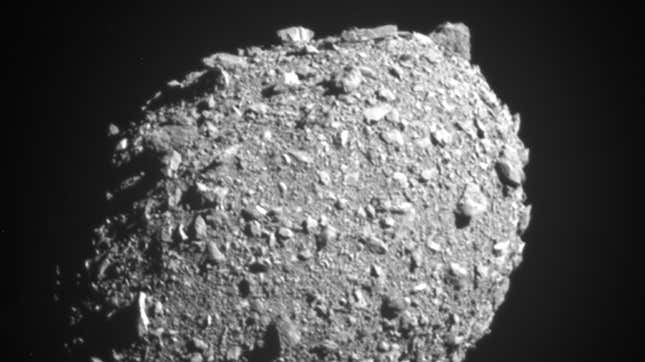
The results are in from NASA’s Double Asteroid Redirection Test, or DART, which attempted to deflect an asteroid: NASA has forever reshaped the Didymos-Dimorphos system. The successful test points to a possible planetary defense strategy for protecting Earth against hazardous near-Earth objects.
NASA’s 1,340-pound spacecraft smashed into the moonlet on September 26 following a 10 month journey to the binary asteroid system. Astronomers kept a close watch on the pair in the days following the encounter in hopes of detecting a possible change to the system’s orbital dynamics.
Data sets gathered by ground-based optical and radio telescopes show that following the collision, Dimorphos’s orbital period around Didymos changed from taking 11 hours and 55 minutes to 11 hours and 23 minutes, a change of 32 minutes, according to Lori Glaze, director of the Planetary Science Division at NASA.
“For the first time ever, humanity has changed the orbit of a planetary object,” Glaze told reporters.
See more on this story: The Most Intriguing Images of DART’s Fatal Encounter With an Asteroid
A clearly beaming NASA administrator Bill Nelson opened the press briefing by saying: “We showed that NASA is serious as a defender of this planet.” The NASA administrator described the $308 million DART test as a “watershed moment for humanity,” and he’s not wrong: This extraordinary result means we might eventually be able to deflect these existential threats and even re-engineer the solar system in advantageous ways.
Four different optical observatories in Chile and South Africa contributed to the analysis, as did the Green Bank and Goldstone radio telescopes. The two independent data sets pointed to the same answer of 32 minutes, with a margin of uncertainty for around plus or minus two minutes.

Lori Glaze said the DART team would’ve been thrilled with a 73-second change to Dimorphos’s orbit, as that was deemed the minimal amount needed for a successful demonstration. The 32-minute adjustment fell within the bounds of the models, but at the extreme upper end of the predicted range, she explained.
Nancy Chabot, DART coordination lead at the Johns Hopkins Applied Physics Laboratory, said the enhanced effect of the impact was likely due to the large amount of material kicked up from the surface by the collision. The fridge-sized DART was traveling at 14,000 miles per hour (22,500 kilometers per hour) when it struck the unsuspecting asteroid. It also helped that Dimorphos is essentially a rubble pile: Going into the mission, astronomers weren’t sure if the 525-foot-wide (160-meter) asteroid was a solid body or a loose conglomeration of rocks.
When DART’s DRACO camera outed Dimorphos as a rubble pile asteroid, Tom Statler, DART program scientist at NASA, said he “knew it was not going to be 73 seconds.” Statler told reporters that the recoil from the ejecta—the surface material blown off the asteroid—was a major contributor to the orbital change. It was akin to air being blown out of a balloon.
As a result of the test, Dimorphos is now tens of meters closer to the 2,650-foot-wide (780-meter) Didymos and more tightly bound to its larger host. The asteroids are 0.75 miles (1.2 km) apart, while the system itself is 6.8 million miles (11 million km) from Earth.
But as Statler explained, DART may have done more than just shorten Dimorphos’s orbit around Didymos. It’s possible that the impact introduced a wobble, both to its orbit and the moonlet itself. Future observations are needed to confirm this, he explained. “We’re just at the beginning of this rich dataset,” Statler said, adding that there’s a “lot of work ahead of us to really understand what happened.”
It became clear that the impact had a big effect on the system in the hours and days following the impact. The Italian LICIACube spacecraft, which came along for the journey, snapped photos immediately after the impact, revealing unexpected tentacle-like debris plumes. Views from ground-based telescopes and the Hubble and Webb space telescopes likewise revealed significant amounts of debris kicked up by the impact. Dimorphos, according to Glaze, has developed a comet-like tail, the result of solar winds blowing the fine-grained particles away from the moonlet.
DART is a spectacular success, but plenty of work remains to be done. Not all asteroids are loose collections of debris, so scientists will likely want to measure the effect that similar kinetic impacts will have on more solid targets. But as Glaze made clear during the briefing, the biggest priority right now is to “complete our inventory” of asteroids in the solar system that “are potentially dangerous to Earth.”
NASA’s upcoming Near-Earth Object Surveyor, an infrared space telescope slated for launch in 2026, should help immensely in this regard.
More: NASA’s DART Is No More, but This Future Probe Is Hoping to Take a Second Look.